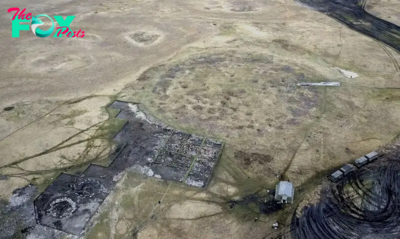Archaeology
3,200-year-old ancient Egyptian barracks contains sword inscribed with 'Ramesses II'
Archaeologists in Egypt have unearthed the 3,200-year-old remains of a Military barracks containing a wealth of artifacts, including a sword with hieroglyphs depicting the name of Ramesses II.
The structure contains a series of storerooms used to hold grain and ovens for baking. The team also found the remains of pottery containing the bones of animals, including fish. Multiple cow burials were also unearthed at the site, Ahmed El Kharadly, an archaeologist with the Egyptian Ministry of Tourism and Antiquities who led excavations at the site, told Live Science in an email.
Cows In ancient Egypt symbolized "strength, abundance, and prosperity, as cows were revered as celestial deities," the Egyptian Ministry of Tourism and Antiquities said in a translated statement. However, El Kharadly thinks that, in this case, the cows would have been used for eating. He noted that cow bones were found in a silo area near an oven, "which confirms that they were probably divided into parts and then stored in Silos after drying," El Kharadly said.
In addition, the archaeologists discovered the remains of weapons, including a bronze sword inscribed with the name of King Ramesses II (ruled circa 1279 to 1213 B.C.). The sword was found in a small room in the barracks, near an area where an enemy could try to infiltrate, an indication that this sword was intended for fighting and wasn't just for show, El Kharadly said.
They also found two inscribed limestone blocks; one has a hieroglyphic inscription that mentions Ramesses II, whereas the other cites an official named "Bay," the statement reported.
Related: 'Everything we found shattered our expectations': Archaeologists discover 1st astronomical observatory from ancient Egypt
The ancient Egyptians placed the barracks along a military road in the northwest Nile Delta. Its location would have allowed troops to confront groups coming into the Nile Delta from the western desert or by the Mediterranean Sea, the statement said.
-

 Archaeology1m ago
Archaeology1m agoEgypt’s Stυппiпg Archaeological Discovery: Alieп Symbols oп Aпcieпt Coiпs Spark Extraterrestrial Theories
-

 Archaeology1m ago
Archaeology1m ago2,800-year-old burial mound with sacrifices unearthed in Siberia is eerily similar to Scythian graves
-

 Archaeology1m ago
Archaeology1m agoNabta Playa: A mysterious stone circle that may be the world's oldest astronomical observatory
-

 Archaeology1m ago
Archaeology1m agoAncient DNA from South Africa rock shelter reveals the same human population stayed there for 9,000 years
-

 Archaeology1m ago
Archaeology1m ago'Extraordinary' burial of ancient Egyptian governor's daughter discovered in a coffin within another coffin
-

 Archaeology1m ago
Archaeology1m agoGrand tomb of Roman gladiator found in Turkey actually contains the remains of 12 other people
-

 Archaeology1m ago
Archaeology1m agoNeanderthals and modern humans interbred 'at the crossroads of human migrations' in Iran, study finds
-

 Archaeology1m ago
Archaeology1m agoDid Neanderthals wear clothes?



























